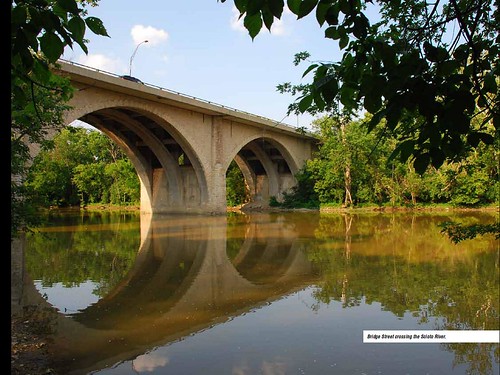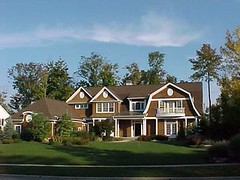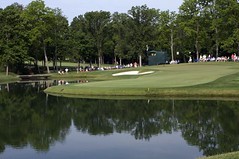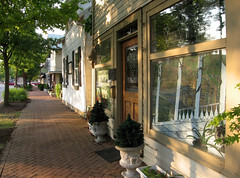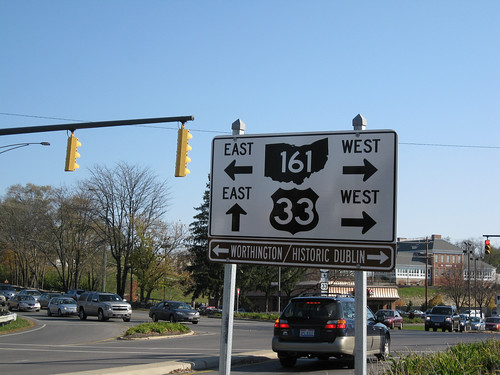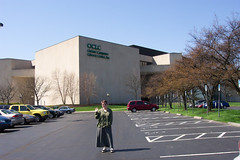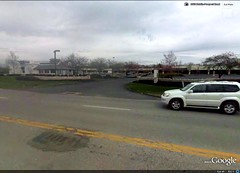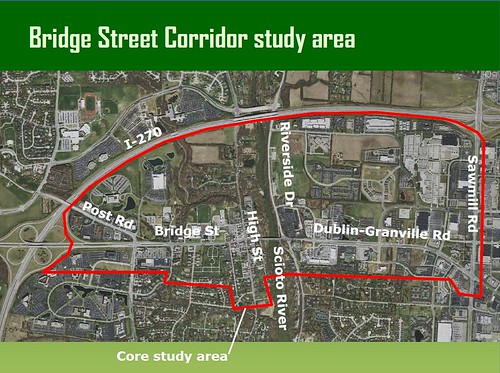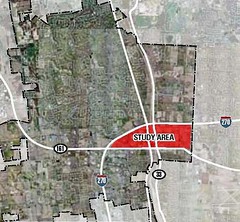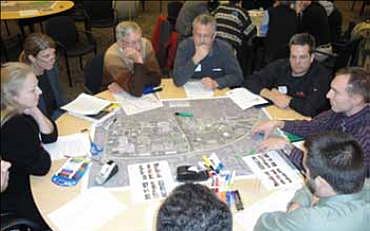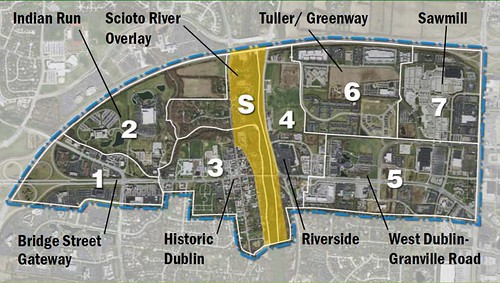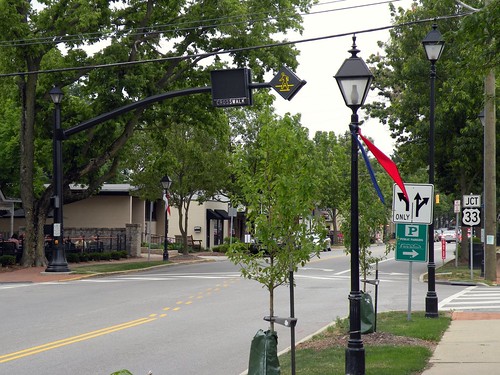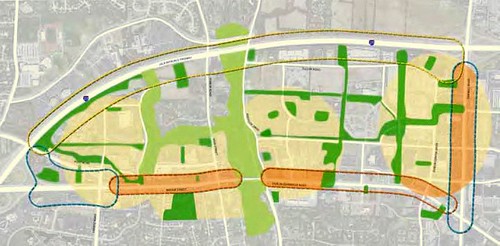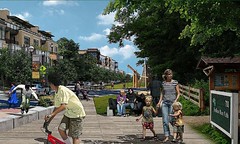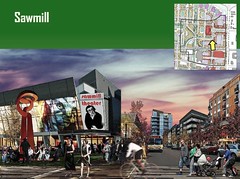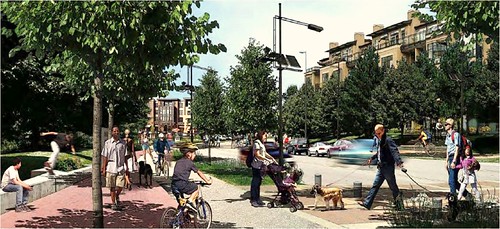Remaking a suburb for the creative class

Posted October 21, 2010 at 1:28PM
By almost any conventional measure, Dublin, Ohio is a wildly successful community. A suburb of Columbus, Dublin is one of the wealthiest municipalities in Ohio, with a median family income of $126,402, more than double that for the nation as a whole. Unlike Midwestern cities founded in earlier days on an industrial economy, Dublin is a modern community that has experienced tremendous growth in recent decades, with fewer than 4,000 residents as recently as 1980, but upwards of 38,000 today.
Dublin is now home to the headquarters of Wendy’s, Ashland, Cardinal Health and several other corporations, including the new-technology OCLC (originally Online Computer Library Center). Nationwide Insurance and Verizon have significant presence there. The Professional Golf Association’s Memorial Tournament, one of its more prominent events, is hosted by Ohio native Jack Nicklaus and held annually in Dublin, and the community’s excellent golfing facilities also host numerous other events. The Scioto River runs through the heart of town, which also can boast a very pleasant historic district. It’s all working; you may wonder, why change anything?
The answer is that Dublin’s leaders are thinking like a business. They know that their success has been based on a late-20th century model of office parks, malls, and single-family subdivisions that is now becoming outdated. Having been on the leading edge of past suburban success, they want to be on the leading edge for the 21st century as well. And right now, although they have great assets to build upon, they suspect that they aren’t ready for the new generation of “customers.”
Outside of the relatively small historic district, for example, Dublin's main transportation corridors are lined with development that is relentlessly automobile-oriented and unwalkable, and frequently bland. What a visitor sees may mask an affluent community, but it also lacks cohesion and resembles nothing so much as run-of-the-mill sprawl, so typical of suburbs built in the 1980s and 1990s:
As recent city manager Terry Foegler told Holly Zachariah of The Columbus Dispatch, what Dublin is missing is what it needs to attract young professionals and empty-nesters: “a trendy, urban area in which to work, play and live.”
While some residents are rightly attentive to be sure that historic character is preserved, Eric Leslie of the Historic Dublin Business Association echoes the need to evolve. Leslie told Zachariah that development that would get people to live downtown, make walking and biking there easier, and give them something to do would be wonderful: "We need an area where people can stroll and hang out, where people can have some fun. What we need is an energy."
In response, the city council has been working on something called the Bridge Street Corridor Study, a bureaucratic name for an exercise to determine whether there are parts of the community’s central area that could be re-imagined to accommodate more walkable, livelier development. Technical support is being provided by Goody, Clancy & Associates, an architecture and planning firm that has advised clients all over the country - and the world, for that matter - on contextually appropriate urbanist makeovers. (Disclosure: Goody, Clancy’s David Dixon is a close professional friend.) Bridge Street is Dublin’s principal east-west artery, though it takes other names along the way; it runs through the heart of commercial Dublin and the historic district. The street is also Ohio Route 161 and, in places, US Highway 33.
Goody Clancy began the right way, listening to businesses and residents, while bringing in nationally recognized experts including Chris Leinberger, Laurie Volk, and Carol Coletta to offer perspective on development trends and markets. All advised the community to go walkable and mixed-use to be positioned for the future.
"Honestly, I don't know that any part of it came as a complete surprise to me, particularly in terms of housing stock and the kind of lifestyle environment that young professionals might be seeking," council member Tim Lecklider told Jennifer Noblit of ThisWeek Dublin. "I've been saying for several years on council that we probably have a full complement of single-family homes for a community of our size. To build any more could create a glut of that type of housing."
Noblit’s article, which was published in December of last year, suggests that other council members are in general agreement, though some have a natural concern that the makeover occur in the right places. Council member Richard Gerber told Noblit that an evolution to accommodate 21st-century lifestyle preferences could be seen as "the natural progression of things. We built a town and now we have fine neighborhoods that have attracted business. I think in some way this is just one more part of the process."
From talking to residents, businesses and community leaders, Goody, Clancy found that Dublin is facing increased competition from downtown Columbus, other suburbs, and other parts of the country for the young talent needed to supply the diverse, skilled workforce sought by modern employers. “As many as 60,000 people work in Dublin in the course of a year,” Foegler told Philip Langdon of New Urban News; between 5,000 and 8,000 employees are hired every year in the community.
Goody, Clancy subcontractor and market analysts Zimmerman, Volk Associates found that, while “there is projected demand for about 1,500 housing units over the next 5-7 years in the study area,” most of that will be for housing more suited to singles and empty nesters than the community’s current housing stock. Indeed, apart from the city's study and as further evidence of a changing attitude, the high-tech OCLC is already examining walkable development alternatives for the 80 acres it owns in Dublin.
Goody, Clancy’s preliminary inquiry recognized that it will be important to build in a way that creates and strengthens neighborhoods, not just adds to them; that development should strengthen, not diminish, the town’s historic district and character; that transportation choices and more complete streets would be required; that the community’s greenway and open space network can grow.
The firm believes that the Bridge Street Corridor is an appropriate place to focus, with significant redevelopment opportunity due to the presence of several large parcels of land under single ownership (including commercial properties well past their prime), and several property owners seeking higher-value uses for their land. Focusing on the corridor would also present opportunities for increasing connectivity and transportation access, while avoiding impacts on the community’s single-family neighborhoods, which mostly lie outside the study area. Many of the details may be found in a Planning Foundations document presented in May of this year by Goody, Clancy to the city.
The firm presented its vision for the corridor to the city earlier this month. Goody, Clancy focused on neighborhoods, key arteries with potential for improvement, and expanding the park and trail system. Their goal was to illustrate how the city could use thoughtful planning and redevelopment to achieve a future with these outcomes:
- The Bridge Street Corridor is Dublin’s centerpiece. Dublin’s historical and cultural heart is strengthened and balanced by highly walkable districts and neighborhoods on both sides of the Scioto River.
- Exceptional green spaces preserve the outstanding natural features in the corridor and seamlessly connect each unique district along the corridor.
- Mixed-use districts bring together complementary arrangements of living, working and recreation in memorable settings created by distinctive, human-scaled architecture and streets that invite walking and gathering.
- Greatly expanded choices in housing, employment, activities and transportation attract new generations of residents, businesses and visitors.
- The Bridge Street Corridor radiates a diversity and vitality that mark it as a special place not only within Dublin, but within the region, nation and world.
The concept is ambitious, integrating new townhome, multi-family and loft housing, new office space, new shopping and civic facilities, roof gardens, a trail network, and even space for a light rail line, amidst a fair amount of retained existing buildings.
Recommendations were differentiated for different sub-districts and neighborhoods. (See numbered sections in image of the planning area above.) Below, for example, are illustrative possibilities for (clockwise from upper left) the Indian Run district; the edge of the Indian Run district, bordering a natural area; the Sawmill district; and the Riverside district.
Earlier this month, urbanist trend-spotter Richard Florida wrote in The Wall Street Journal that, to do well in today's economy, suburbs need a bit of urban character:
“Just a couple of decades ago, the suburbs were the very image of the American Dream, with their sprawling, large-lot homes and expansive lawns. Suburban malls, industrial parks and office campuses accounted for a growing percentage of the nation's economic output. Planners talked about ‘edge cities’—satellite centers where people could live, work and shop without ever having to set foot in major cities.
“With millions of American homes now ‘underwater’ or in foreclosure, the suburbs and exurbs have taken some of the most visible hits from the great recession . . . The suburbs that have continued to prosper during the downturn share many attributes with the best urban neighborhoods: walkability, vibrant street life, density and diversity. The clustering of people and firms is a basic engine of modern economic life. When interesting people encounter each other, they spark new ideas and accelerate the formation of new enterprises. Renewing the suburbs will require retrofitting them for these new ways of living and working.”
Later in his article, Florida makes clear that he believes that suburbs that take the necessary steps to become more walkable and urbane will be well-positioned to compete for the creative class (a phrase he coined):
“Walkable suburbs are some of America's best places to live, and they provide their sprawling, spread-out siblings with a model for renewal. Relatively dense commercial districts, with shops, restaurants and movie theaters, as well as a wide variety of housing types, have always been a feature of the older suburbs that grew up along the streetcar lines of big metro areas . . .
“These are the places where Americans are clamoring to live and where housing prices have held up even in the face of one of the greatest real-estate collapses in modern memory. More than that, as my colleague Charlotta Mellander and I found when we looked into the statistics, the U.S. metro areas with walkable suburbs have greater economic output and higher incomes, more highly educated people, and more high-tech industries, to say nothing of higher levels of happiness.”
While it remains to be seen how much of Goody, Clancy’s vision will be adopted by Dublin as a viable plan, and what the details will be, what impresses me most is the foresight of the community’s leaders in undertaking the Bridge Street Corridor Study and understanding the opportunity they have to be just as relevant to the next thirty years as they have been to the last thirty. The city now has some important things to think about, and I’m pulling for them.
Move your cursor over the images for credit information.
